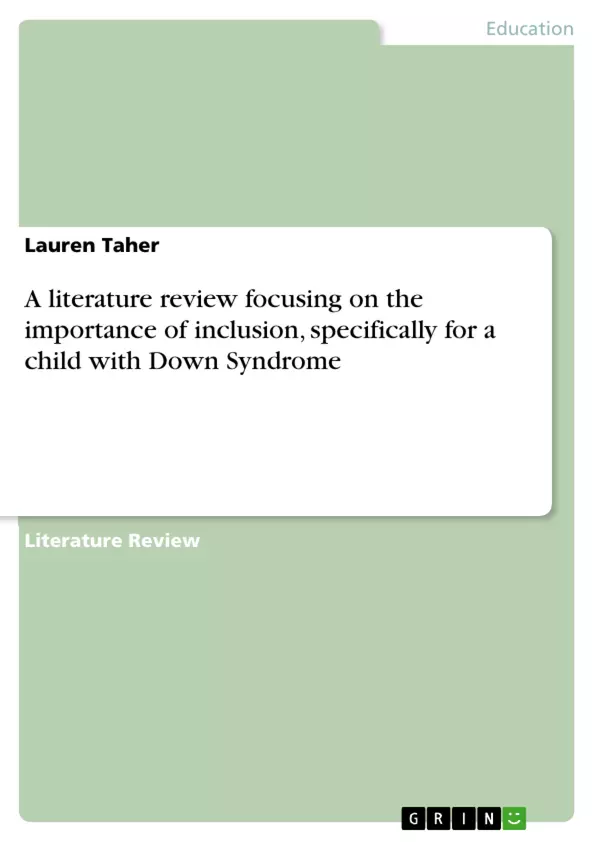This literature review will focus on the importance of inclusion within the primary school classroom and the wider school environment. The main focus will be Julie, a five year old child with the genetic condition Down’s Syndrome, that according to the NHS (2014), causes a level of learning disability and a characteristic range of physical features. Under the Equality Act (2010), Julie, has ‘a physical or mental impairment’ which has a ‘substantial and long-term adverse effect on [her] ability to carry out normal day-to-day activities’. Relevant literature will be reviewed throughout this assignment, including a number of educational policies, to establish the importance of inclusion, especially in relation to Julie and her individual needs.
Inhaltsverzeichnis (Table of Contents)
- Introduction
- Down's Syndrome: A Definition and Its Effects
- The Importance of Inclusion and Differentiation
- Differentiation within the Classroom Environment
- Parental Involvement and Responsibilities
- Visual Aids and Communication
- Outdoor Play and Physical Activity
- Assessment and Monitoring Progress
- Conclusion
Zielsetzung und Themenschwerpunkte (Objectives and Key Themes)
This literature review aims to explore the importance of inclusion for children with Down's Syndrome within the primary school setting. It focuses on the specific case of Julie, a five-year-old child with Down's Syndrome, and examines how her individual needs can be met in an inclusive environment.
- The importance of inclusive education for children with Down's Syndrome
- Strategies and techniques to support the learning and development of children with Down's Syndrome
- The role of parental involvement in supporting children with Down's Syndrome
- The use of visual aids and communication strategies to promote inclusion
- Differentiation in the classroom to meet the needs of all learners
Zusammenfassung der Kapitel (Chapter Summaries)
- Introduction: This section provides a brief overview of the topic of inclusion for children with Down's Syndrome and introduces the case study of Julie, a five-year-old child with Down's Syndrome. It outlines the focus of the review, which is to explore the importance of inclusion in the primary school environment, particularly in relation to Julie and her individual needs.
- Down's Syndrome: A Definition and Its Effects: This chapter delves into the definition and characteristics of Down's Syndrome, drawing from relevant literature and research to provide a comprehensive understanding of the condition. It highlights the potential challenges that children with Down's Syndrome may face, including learning difficulties, physical characteristics, and health issues. The chapter also mentions Julie's specific situation, including her heart condition.
- The Importance of Inclusion and Differentiation: This chapter explores the theoretical framework of inclusive education and the importance of differentiated teaching for students with Down's Syndrome. It examines relevant educational policies and literature that underscore the importance of meeting the individual needs of all learners. The chapter highlights the benefits of inclusion for children with Down's Syndrome, emphasizing their right to a quality education that maximizes their potential.
- Differentiation within the Classroom Environment: This chapter delves into practical strategies for differentiating teaching and learning in the classroom, focusing on how these strategies can be applied to support the specific needs of Julie. It discusses various techniques, such as the use of visual aids, communication strategies, and alternative learning methods, which can help to create a more inclusive environment for children with Down's Syndrome.
- Parental Involvement and Responsibilities: This chapter highlights the crucial role of parental involvement in the education of children with Down's Syndrome. It discusses the importance of communication and collaboration between schools and parents, emphasizing the need for regular reviews and discussions about the child's progress and learning goals. The chapter explores the benefits of parental responsiveness and the potential of using techniques like Responsive Teaching to promote children's development.
- Visual Aids and Communication: This chapter focuses on the use of visual aids and alternative communication strategies to support the learning and communication of children with Down's Syndrome. It examines the advantages of using visual representations, such as photographs and symbols, to enhance communication and comprehension. The chapter also explores the use of sign language and other non-verbal methods to promote inclusion and reduce frustration for children with Down's Syndrome.
- Outdoor Play and Physical Activity: This chapter discusses the importance of outdoor play and physical activity for the development of children with Down's Syndrome. It examines the potential benefits of outdoor experiences for promoting learning, problem-solving skills, and social competence. The chapter also highlights the importance of planning differentiated activities to ensure that all children, including those with Down's Syndrome, can participate and engage in outdoor play.
- Assessment and Monitoring Progress: This chapter focuses on the assessment and monitoring of progress for children with Down's Syndrome. It highlights the importance of setting individual goals and using various assessment methods, including formative assessments, to monitor their progress and ensure they are meeting their targets. The chapter also emphasizes the need to track the effectiveness of intervention strategies and make adjustments as needed.
Schlüsselwörter (Keywords)
The primary keywords and focus topics of this review include inclusion, Down's Syndrome, differentiation, parental involvement, visual aids, communication strategies, outdoor play, assessment, and monitoring progress. The review emphasizes the importance of creating an inclusive environment for children with Down's Syndrome, utilizing effective teaching practices, and maximizing their learning potential.
- Quote paper
- Lauren Taher (Author), 2013, A literature review focusing on the importance of inclusion, specifically for a child with Down Syndrome, Munich, GRIN Verlag, https://www.grin.com/document/437350



